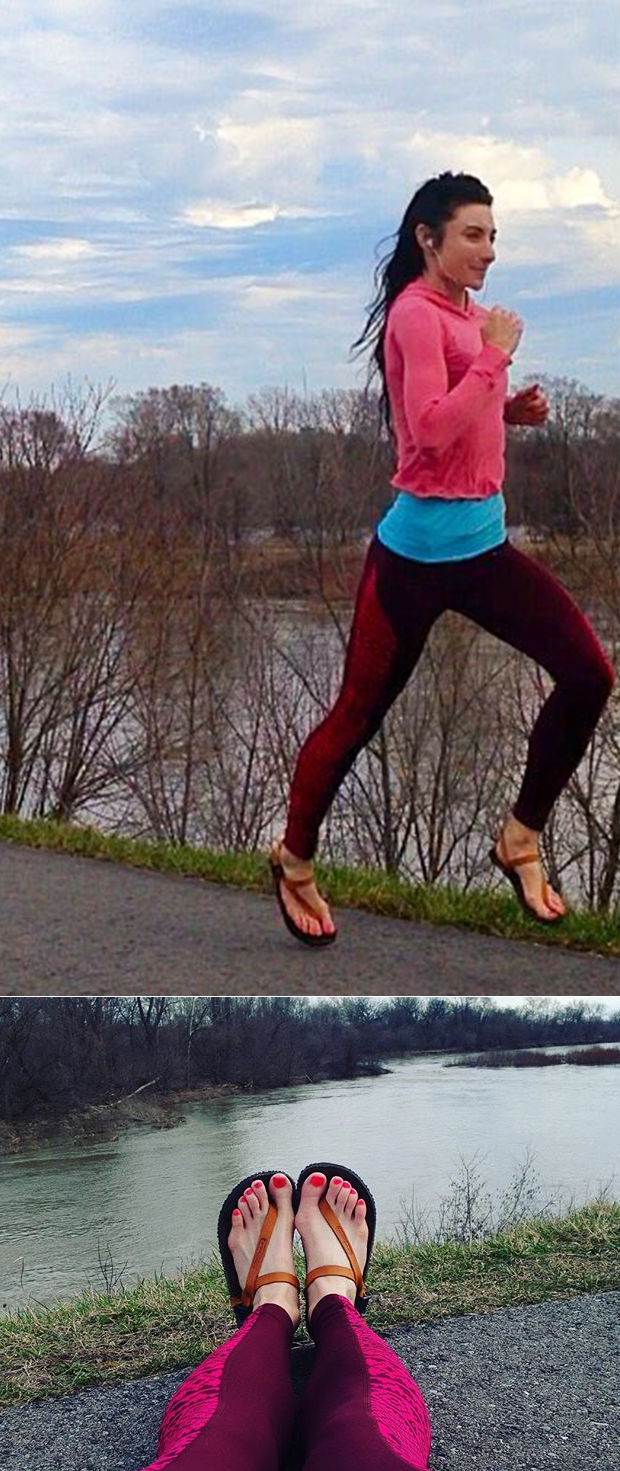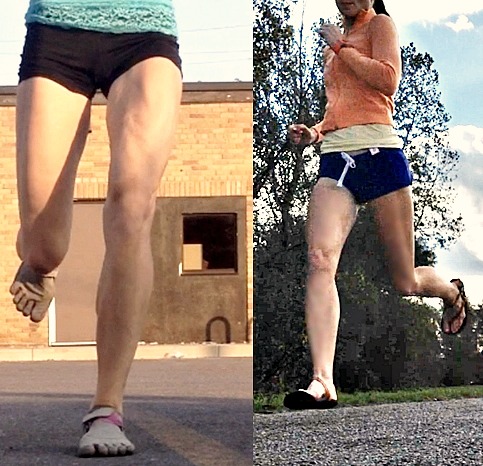If there is one type of shoe that you should wear when learning forefoot running, it’s barefoot feeling shoes because you’ll be more economical. This is because barefoot feeling shoes feel harder on the soles of the feet as compared to regular running shoes which often feel overly soft and squishy whereby the feeling of softness often felt in most running shoes may hurt your performance. For example, a study by Kim et al. 2011 found that leg-spring was higher when runners landed on non-compliant (hard) surfaces compared to compliant (soft) surfaces.

More Good News About Barefoot Feeling Shoes
The standard running shoe is heavily cushioned thereby acting as a soft, compliant plantar surface during running. Likewise, many of these shoes are advertised as having soles that provide substantial ‘energy return’.
On the contrary however, leg-spring, which is the leg’s natural ability to store elastic energy –primarily in the foot arch and Achilles tendon — decreases on softer plantar surfaces. In fact, leg-spring capacity increases with surface hardness! This is why habitual barefoot runners and pure minimalist runners, who run on the road, have greater leg-spring capacity than habitual shod runners. From an anthropic viewpoint, barefoot running enabled us to be highly efficient runners regardless of surface hardness, and thus, enabled us to make better use of the elastic structure of our legs.

Leg-Spring Depends on Surface
The big picture is leg-spring capacity is directly related to running surfaces as well as biomechanics. Landing with a forefoot strike allows for greater energy storage in the lower leg. But, forefoot running on harder surfaces is even better at optimizing leg-spring function as compared with forefoot running on softer, squishy surfaces. Here’s why:
- The body naturally adjusts leg-spring capacity in response to different surfaces while similar running mechanics are maintained.
- For instance, in addition to a forefoot strike landing, increased knee flexion and ankle plantar flexion is an adaptation to running barefoot on hard surfaces.
- These variables not only allow barefoot runners to escape the confines of injury, but maximizes leg-spring.
The problem with cushioned running shoes is that they reverse the kinematic adaptations induced by barefoot running. That is, knee flexion decreases and so does ankle plantar flexion. One explanation for this apparent paradox is that the plantar surface is perceived as comfortable in cushioned running shoes.
This is why increased knee flexion is not needed to provide additional comfort when running in cushy shoes, however it IS needed for better running economy! Remember: increased knee flexion = better leg-spring.
The Harder, the Better
Harder plantar surfaces such as running barefoot or in pure minimalist running shoes is responsible for regulating joint-flexion needed for better leg-spring and therefore energy return.
Until recently, the notion that barefoot running enhanced performance seemed absurd. Now, the relationship between barefoot running and leg-spring capacity is becoming more thoroughly studied.
The evidence is now very convincing, especially since the best runners in the world grew up running barefoot and evolved adaptations of better leg-spring capacity than runners of habitual shod populations.
More From Run Forefoot:
- Is Barefoot Running Bad?
- The Meaning of Calf Soreness in Forefoot Running
- How Forefoot and Heel Running Effects Achilles Function
- What are the Proper Shoes for Forefoot Running
References:
Ferris, D.P., Liang, K., Farley, C.T., 1999. Runners adjust leg stiffness for their first step on a new running surface. Journal of Biomechanics 32 (8), 787–794.
Ferris, D.P., Louie, M., Farley, C.T., 1998. Running in the real world: adjusting leg stiffness for different surfaces. Proceedings of the Biological Sciences 265 (1400), 989–994.
Kim et al. The natural frequency of the foot-surface cushion during the stance phase of running. J Biomech, 2011; 44:774-79.
Kim, W., Voloshin, A.S., Johnson, S.H., 1994. Modeling of heel strike transients during running. Human Movement Science 13, 221–244.
Robbins SE., Hanna AM and Jones, L. Sensory attenuation induced by modern athletic footwear. J Test Eval, 1988; 16:412-16.
Bretta Riches
BSc Neurobiology; MSc Biomechanics candidate, ultra minimalist runner & founder of RunForefoot. I was a heel striker, always injured. I was inspired by the great Tirunesh Dibaba to try forefoot running. Now, I'm injury free. This is why I launched Run Forefoot, to advocate the health & performance benefits of forefoot running and to raise awareness on the dangers of heel striking, because the world needs to know.
Latest posts by Bretta Riches (see all)
- Heel Lifts Increase Injury in Runners - 16/04/2024
- Are Minimalist Shoes Good for Seniors? YES! - 14/04/2024
- BIG Deals On Running Gear And More! - 09/04/2024

Leave a Reply